Magnetosphere of Jupiter
| Total power | 100 TW |
|---|---|
| Radio emission frequencies | 0.01–40 MHz |
The magnetosphere of Jupiter is the cavity created in the
Jupiter's internal magnetic field is generated by electrical currents in the planet's outer core, which is theorized to be composed of liquid
The action of the magnetosphere traps and accelerates particles, producing intense belts of
Structure

Jupiter's magnetosphere is a complex structure comprising a
Internal magnetic field
The bulk of Jupiter's magnetic field, like
The dipole is tilted roughly 10° from Jupiter's axis of rotation; the tilt is similar to that of the Earth (11.3°).
Size and shape
Jupiter's internal magnetic field prevents the
As with Earth's magnetosphere, the boundary separating the denser and colder solar wind's plasma from the hotter and less dense one within Jupiter's magnetosphere is called the magnetopause.[6] The distance from the magnetopause to the center of the planet is from 45 to 100 RJ (where RJ=71,492 km is the radius of Jupiter) at the subsolar point—the unfixed point on the surface at which the Sun would appear directly overhead to an observer.[6] The position of the magnetopause depends on the pressure exerted by the solar wind, which in turn depends on solar activity.[19] In front of the magnetopause (at a distance from 80 to 130 RJ from the planet's center) lies the bow shock, a wake-like disturbance in the solar wind caused by its collision with the magnetosphere.[20][21] The region between the bow shock and magnetopause is called the magnetosheath.[6]
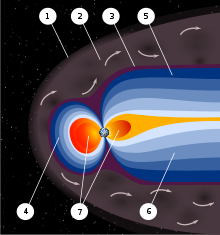
At the opposite side of the planet, the solar wind stretches Jupiter's magnetic field lines into a long, trailing
The shape of Jupiter's magnetosphere described above is sustained by the neutral sheet current (also known as the magnetotail current), which flows with Jupiter's rotation through the tail plasma sheet, the tail currents, which flow against Jupiter's rotation at the outer boundary of the magnetotail, and the magnetopause currents (or Chapman–Ferraro currents), which flow against rotation along the dayside magnetopause.[11] These currents create the magnetic field that cancels the internal field outside the magnetosphere.[22] They also interact substantially with the solar wind.[11]
Jupiter's magnetosphere is traditionally divided into three parts: the inner, middle and outer magnetosphere. The inner magnetosphere is located at distances closer than 10 RJ from the planet. The magnetic field within it remains approximately dipole, because contributions from the currents flowing in the magnetospheric equatorial plasma sheet are small. In the middle (between 10 and 40 RJ) and outer (further than 40 RJ) magnetospheres, the magnetic field is not a dipole, and is seriously disturbed by its interaction with the plasma sheet (see magnetodisk below).[6]
Role of Io
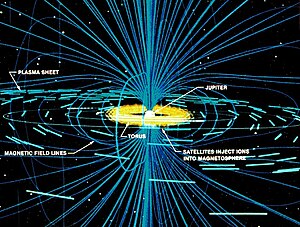
Although overall the shape of Jupiter's magnetosphere resembles that of the Earth's, closer to the planet its structure is very different.
As a result of several processes—
Magnetodisk
While Earth's magnetic field is roughly teardrop-shaped, Jupiter's is flatter, more closely resembling a disk, and "wobbles" periodically about its axis.
The configuration of the magnetodisk's field is maintained by the azimuthal ring current (not an analog of Earth's ring current), which flows with rotation through the equatorial plasma sheet.[32] The Lorentz force resulting from the interaction of this current with the planetary magnetic field creates a centripetal force, which keeps the co-rotating plasma from escaping the planet. The total ring current in the equatorial current sheet is estimated at 90–160 million amperes.[6][26]
Dynamics
Co-rotation and radial currents

The main driver of Jupiter's magnetosphere is the planet's rotation.
The current flowing from the ionosphere to the plasma sheet is especially strong when the corresponding part of the plasma sheet rotates slower than the planet.
The acceleration of the plasma into the co-rotation leads to the transfer of energy from the Jovian rotation to the kinetic energy of the plasma.[6][25] In that sense, the Jovian magnetosphere is powered by the planet's rotation, whereas the Earth's magnetosphere is powered mainly by the solar wind.[25]
Interchange instability and reconnection
The main problem encountered in deciphering the dynamics of the Jovian magnetosphere is the transport of heavy cold plasma from the Io torus at 6 RJ to the outer magnetosphere at distances of more than 50 RJ.

This highly hypothetical picture of the flux tube exchange was partly confirmed by the
When flux tubes loaded with the cold Ionian plasma reach the outer magnetosphere, they go through a
The reconnection events are analogues to the magnetic substorms in the Earth's magnetosphere.[35] The difference seems to be their respective energy sources: terrestrial substorms involve storage of the solar wind's energy in the magnetotail followed by its release through a reconnection event in the tail's neutral current sheet. The latter also creates a plasmoid which moves down the tail.[42] Conversely, in Jupiter's magnetosphere the rotational energy is stored in the magnetodisk and released when a plasmoid separates from it.[40]
Influence of the solar wind
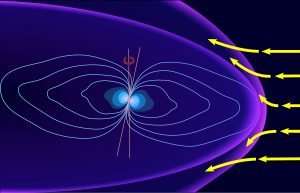
Whereas the dynamics of the Jovian magnetosphere mainly depend on internal sources of energy, the solar wind probably has a role as well,[43] particularly as a source of high-energy protons.[note 3][7] The structure of the outer magnetosphere shows some features of a solar wind-driven magnetosphere, including a significant dawn–dusk asymmetry.[26] In particular, magnetic field lines in the dusk sector are bent in the opposite direction to those in the dawn sector.[26] In addition, the dawn magnetosphere contains open field lines connecting to the magnetotail, whereas in the dusk magnetosphere, the field lines are closed.[22] All these observations indicate that a solar wind driven reconnection process, known on Earth as the Dungey cycle, may also be taking place in the Jovian magnetosphere.[35][43]
The extent of the solar wind's influence on the dynamics of Jupiter's magnetosphere is currently unknown;[44] however, it could be especially strong at times of elevated solar activity.[45] The auroral radio,[4] optical and X-ray emissions,[46] as well as synchrotron emissions from the radiation belts all show correlations with solar wind pressure, indicating that the solar wind may drive plasma circulation or modulate internal processes in the magnetosphere.[40]
Emissions
Aurorae
| Emission | Jupiter | Io spot |
|---|---|---|
| Radio (KOM, <0.3 MHz) | ~1 GW | ? |
| Radio (HOM, 0.3–3 MHz) | ~10 GW | ? |
| Radio (DAM, 3–40 MHz) | ~100 GW | 0.1–1 GW (Io-DAM) |
| IR (hydrocarbons, 7–14 μm) | ~40 TW | 30–100 GW |
| IR (H3+, 3–4 μm) | 4–8 TW | |
| Visible (0.385–1 μm) | 10–100 GW | 0.3 GW |
| UV (80–180 nm) | 2–10 TW | ~50 GW |
| X-ray (0.1–3 keV) | 1–4 GW | ? |

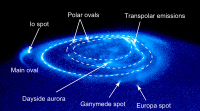

(animation).
Jupiter demonstrates bright, persistent aurorae around both poles. Unlike Earth's aurorae, which are transient and only occur at times of heightened solar activity, Jupiter's aurorae are permanent, though their intensity varies from day to day. They consist of three main components: the main ovals, which are bright, narrow (less than 1000 km in width) circular features located at approximately 16° from the magnetic poles;[48] the satellites' auroral spots, which correspond to the footprints of the magnetic field lines connecting Jupiter's ionosphere with those of its largest moons, and transient polar emissions situated within the main ovals (elliptical field may prove to be a better description).[48][49] Auroral emissions have been detected in almost all parts of the electromagnetic spectrum from radio waves to X-rays (up to 3 keV); they are most frequently observed in the mid-infrared (wavelength 3–4 μm and 7–14 μm) and far ultraviolet spectral regions (wavelength 120–180 nm).[9]
The main ovals are the dominant part of the Jovian aurorae. They have roughly stable shapes and locations,
Spots were found to correspond to the Galilean moons Io,
Bright arcs and spots sporadically appear within the main ovals. These transient phenomena are thought to be related to interaction with either the solar wind or the dynamics of the outer magnetosphere.
Jupiter at radio wavelengths
Jupiter is a powerful source of

The majority of these emissions are thought to be produced by a mechanism called "cyclotron maser instability", which develops close to the auroral regions. Electrons moving parallel to the magnetic field precipitate into the atmosphere while those with a sufficient perpendicular velocity are reflected by the converging magnetic field. This results in an unstable velocity distribution. This velocity distribution spontaneously generates radio waves at the local electron cyclotron frequency. The electrons involved in the generation of radio waves are probably those carrying currents from the poles of the planet to the magnetodisk.[61] The intensity of Jovian radio emissions usually varies smoothly with time. However, there are short and powerful bursts (S bursts) of emission superimposed on the more gradual variations and which can outshine all other components. The total emitted power of the DAM component is about 100 GW, while the power of all other HOM/KOM components is about 10 GW. In comparison, the total power of Earth's radio emissions is about 0.1 GW.[60]
Jupiter's radio and particle emissions are strongly modulated by its rotation, which makes the planet somewhat similar to a
In addition to relatively long-wavelength radiation, Jupiter also emits
Jupiter's magnetosphere ejects streams of high-energy electrons and ions (energy up to tens
Interaction with rings and moons
Jupiter's extensive magnetosphere envelops its ring system and the orbits of all four

Close to Jupiter, the planet's rings and small moons absorb high-energy particles (energy above 10 keV) from the radiation belts.
All Galilean moons have thin atmospheres with surface pressures in the range 0.01–1 nbar, which in turn support substantial ionospheres with electron densities in the range of 1,000–10,000 cm−3.[67] The co-rotational flow of cold magnetospheric plasma is partially diverted around them by the currents induced in their ionospheres, creating wedge-shaped structures known as Alfvén wings.[74] The interaction of the large moons with the co-rotational flow is similar to the interaction of the solar wind with the non-magnetized planets like Venus, although the co-rotational speed is usually subsonic[note 6] (the speeds vary from 74 to 328 km/s), which prevents the formation of a bow shock.[75] The pressure from the co-rotating plasma continuously strips gases from the moons' atmospheres (especially from that of Io), and some of these atoms are ionized and brought into co-rotation. This process creates gas and plasma tori in the vicinity of moons' orbits with the Ionian torus being the most prominent.[67] In effect, the Galilean moons (mainly Io) serve as the principal plasma sources in Jupiter's inner and middle magnetosphere. Meanwhile, the energetic particles are largely unaffected by the Alfvén wings and have free access to the moons' surfaces (except Ganymede's).[76]

The icy Galilean moons, Europa, Ganymede and Callisto, all generate induced magnetic moments in response to changes in Jupiter's magnetic field. These varying magnetic moments create dipole magnetic fields around them, which act to compensate for changes in the ambient field.[67] The induction is thought to take place in subsurface layers of salty water, which are likely to exist in all of Jupiter's large icy moons. These underground oceans can potentially harbor life, and evidence for their presence was one of the most important discoveries made in the 1990s by spacecraft.[77]
The interaction of the Jovian magnetosphere with Ganymede, which has an intrinsic magnetic moment, differs from its interaction with the non-magnetized moons.[77] Ganymede's internal magnetic field carves a cavity inside Jupiter's magnetosphere with a diameter of approximately two Ganymede diameters, creating a mini-magnetosphere within Jupiter's magnetosphere. Ganymede's magnetic field diverts the co-rotating plasma flow around its magnetosphere. It also protects the moon's equatorial regions, where the field lines are closed, from energetic particles. The latter can still freely strike Ganymede's poles, where the field lines are open.[78] Some of the energetic particles are trapped near the equator of Ganymede, creating mini-radiation belts.[79] Energetic electrons entering its thin atmosphere are responsible for the observed Ganymedian polar aurorae.[78]
Charged particles have a considerable influence on the surface properties of Galilean moons. Plasma originating from Io carries sulfur and
Discovery
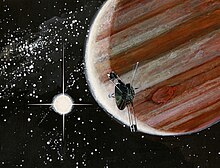
The first evidence for the existence of Jupiter's magnetic field came in 1955, with the discovery of the
In 1959, observations in the
By 1973 the magnetic moment was known within a factor of two, whereas the tilt was correctly estimated at about 10°.
Exploration after 1970
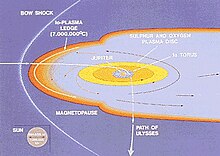
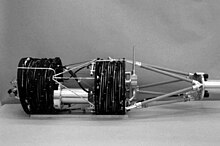
As of 2009 a total of eight spacecraft have flown around Jupiter and all have contributed to the present knowledge of the Jovian magnetosphere. The first space probe to reach Jupiter was Pioneer 10 in December 1973, which passed within 2.9 RJ[18] from the center of the planet.[1] Its twin Pioneer 11 visited Jupiter a year later, traveling along a highly inclined trajectory and approaching the planet as close as 1.6 RJ.[18]
Pioneer 10 provided the best coverage available of the inner magnetic field
Voyagers 1 and 2 arrived at Jupiter in 1979–1980 and traveled almost in its equatorial plane. Voyager 1, which passed within 5 RJ from the planet's center,[18] was first to encounter the Io plasma torus.[6] It received a radiation dosage one thousand times the lethal level for humans, the damage resulting in serious degradation of some high-resolution images of Io and Ganymede.[87] Voyager 2 passed within 10 RJ[18] and discovered the current sheet in the equatorial plane. The next probe to approach Jupiter was Ulysses in 1992, which investigated the planet's polar magnetosphere.[6]
The
When the
In 2003,
Exploration after 2010


The Juno New Frontiers mission to Jupiter was launched in 2011 and arrived at Jupiter in 2016. It includes a suite of instruments designed to better understand the magnetosphere, including a magnetometer as well as other devices such as a detector for plasma and radio waves called Waves.
The Jovian Auroral Distributions Experiment (JADE) instrument should also help to understand the magnetosphere.[91]
A primary objective of the Juno mission is to explore the polar magnetosphere of Jupiter. While Ulysses briefly attained latitudes of ~48 degrees, this was at relatively large distances from Jupiter (~8.6 RJ). Hence, the polar magnetosphere of Jupiter is largely uncharted territory and, in particular, the auroral acceleration region has never been visited. ...
— A Wave Investigation for the Juno Mission to Jupiter[92]
Juno revealed a planetary magnetic field rich in spatial variation, possibly due to a relatively large dynamo radius. The most surprising observation until late 2017 was the absence of the expected magnetic signature of intense field aligned currents (
One of the goals of the European Space Agency's Jupiter Icy Moons Explorer (JUICE) mission, launched April, 2023, is to understand the magnetic field from Ganymede and how it impacts Jupiter. Tianwen-4 is a proposed Chinese mission that will either explore the moon Callisto or gather more information on Io.
Notes
- ^ The magnetic moment is proportional to the product of the equatorial field strength and cube of Jupiter's radius, which is 11 times larger than that of the Earth.
- ^ The direct current in the Jovian magnetosphere is not to be confused with the direct current used in electrical circuits. The latter is the opposite of the alternating current.
- ^ The Jovian ionosphere is another significant source of protons.[7]
- ^ The non-Io-DAM is much weaker than the Io-DAM, and is the high-frequency tail of the HOM emissions.[60]
- ^ A Lorentz resonance is one that exists between a particle's orbital speed and the rotation period of a planet's magnetosphere. If the ratio of their angular frequencies is m:n (a rational number) then scientists call it an m:n Lorentz resonance. So, in the case of a 3:2 resonance, a particle at a distance of about 1.71 RJ from Jupiter makes three revolutions around the planet, while the planet's magnetic field makes two revolutions.[73]
- ^ Technically, the flow is "sub-fast", meaning slower than the fast magnetosonic mode. The flow is faster than the acoustic sound speed.
- ^ Pioneer 10 carried a helium vector magnetometer, which measured the magnetic field of Jupiter directly. The spacecraft also made observations of plasma and energetic particles.[1]
References
- ^ a b c d e Smith, 1974
- ^ a b c d Khurana, 2004, pp. 3–5
- ^ a b Russel, 1993, p. 694
- ^ a b c Zarka, 2005, pp. 375–377
- ^ Blanc, 2005, p. 238 (Table III)
- ^ a b c d e f g h i j k l m n o p q r s Khurana, 2004, pp. 1–3
- ^ a b c d e f g Khurana, 2004, pp. 5–7
- ^ a b Bolton, 2002
- ^ a b Bhardwaj, 2000, p. 342
- ^ Khurana, 2004, pp. 12–13
- ^ a b c d Kivelson, 2005, pp. 303–313
- .
- PMID 28546207.
- PMID 28546206.
- ^ Agle, DC (May 20, 2019). "NASA's Juno Finds Changes in Jupiter's Magnetic Field". Jet Propulsion Laboratory. Retrieved June 4, 2019.
- S2CID 182074098.
- ^ "NASA's Juno Finds Changes in Jupiter's Magnetic Field". Jet Propulsion Laboratory.
- ^ a b c d e f g Russel, 1993, pp. 715–717
- ^ a b c Russell, 2001, pp. 1015–1016
- ^ a b Krupp, 2004, pp. 15–16
- ^ Russel, 1993, pp. 725–727
- ^ a b c d Khurana, 2004, pp. 17–18
- ^ a b c Krupp, 2004, pp. 3–4
- ^ a b c d e f Krupp, 2004, pp. 4–7
- ^ a b c Krupp, 2004, pp. 1–3
- ^ a b c d e f Khurana, 2004, pp. 13–16
- ^ a b Khurana, 2004, pp. 10–12
- ^ Russell, 2001, pp. 1024–1025
- ^ a b Khurana, 2004, pp. 20–21
- ^ a b Wolverton, 2004, pp. 100–157
- ^ Russell, 2001, pp. 1021–1024
- ^ Kivelson, 2005, pp. 315–316
- ^ Blanc, 2005, pp. 250–253
- ^ a b c d e Cowley, 2001, pp. 1069–76
- ^ a b c d e f g Blanc, 2005, pp. 254–261
- ^ a b Cowley, 2001, pp. 1083–87
- ^ Russell, 2008
- ^ a b Krupp, 2007, p. 216
- ^ Krupp, 2004, pp. 7–9
- ^ a b c d Krupp, 2004, pp. 11–14
- ^ Khurana, 2004, pp. 18–19
- ^ Russell, 2001, p. 1011
- ^ a b Nichols, 2006, pp. 393–394
- ^ Krupp, 2004, pp. 18–19
- ^ Nichols, 2006, pp. 404–405
- ^ a b Elsner, 2005, pp. 419–420
- ^ Bhardwaj, 2000, Tables 2 and 5
- ^ a b Palier, 2001, pp. 1171–73
- ^ a b c d Bhardwaj, 2000, pp. 311–316
- ^ Cowley, 2003, pp. 49–53
- ^ Bhardwaj, 2000, pp. 316–319
- ^ Bhardwaj, 2000, pp. 306–311
- ^ Bhardwaj, 2000, p. 296
- ^ Miller Aylward et al. 2005, pp. 335–339.
- ^ Clarke, 2002
- ^ Blanc, 2005, pp. 277–283
- ^ Redd, Nola Taylor (April 5, 2018). "Scientists Spot the Ghostly Aurora Footprint of Jupiter's Moon Callisto". space.com. Retrieved June 4, 2019.
- S2CID 135188023.
- ^ Palier, 2001, pp. 1170–71
- ^ a b c d Zarka, 1998, pp. 20,160–168
- ^ Zarka, 1998, pp. 20, 173–181
- ^ a b c Hill, 1995
- ^ a b Zarka, 2005, pp. 371–375
- ^ Santos-Costa, 2001
- ^ Zarka, 2005, pp. 384–385
- ^ Krupp, 2004, pp. 17–18
- ^ a b c d Kivelson, 2004, pp. 2–4
- ^ Johnson, 2004, pp. 1–2
- ^ a b Johnson, 2004, pp. 3–5
- ^ a b Burns, 2004, pp. 1–2
- ^ Burns, 2004, pp. 12–14
- ^ Burns, 2004, pp. 10–11
- ^ a b Burns, 2004, pp. 17–19
- ^ Kivelson, 2004, pp. 8–10
- ^ Kivelson, 2004, pp. 1–2
- ^ Cooper, 2001, pp. 137,139
- ^ a b Kivelson, 2004, pp. 10–11
- ^ a b Kivelson, 2004, pp. 16–18
- ^ Williams, 1998, p. 1
- ^ a b Cooper, 2001, pp. 154–156
- ^ Johnson, 2004, pp. 15–19
- ^ Hibbitts, 2000, p. 1
- ^ a b Johnson, 2004, pp. 8–13
- ^ Burke and Franklin, 1955
- ^ Drake, 1959
- ISBN 978-0-528-81542-3.
- ISBN 978-0-7106-0444-6.
- ^ Fieseler, 2002
- University of Wisconsin-Madison. Archived from the originalon October 16, 2008. Retrieved October 13, 2008.
- ^ Troutman, 2003
- ^ "NASA's Juno and JEDI: Ready to Unlock Mysteries of Jupiter". Johns Hopkins University Applied Physics Laboratory. June 29, 2016. Archived from the original on March 24, 2017. Retrieved February 7, 2017.
- Bibcode:2008AGUFMSM41B1680K.
- PMID 28546207.
Cited sources
- Bhardwaj, A.; Gladstone, G.R. (2000). "Auroral emissions of the giant planets". Reviews of Geophysics. 38 (3): 295–353. .
- Blanc, M.; Kallenbach, R.; Erkaev, N. V. (2005). "Solar System magnetospheres". Space Science Reviews. 116 (1–2): 227–298. S2CID 122318569.
- Bolton, S.J.; Janssen, M.; et al. (2002). "Ultra-relativistic electrons in Jupiter's radiation belts". Nature. 415 (6875): 987–991. PMID 11875557.
- Burke, B. F.; Franklin, K. L. (1955). "Observations of a variable radio source associated with the planet Jupiter". .
- Burns, J. A.; Simonelli, D. P.; Showalter; Hamilton; Porco; Throop; Esposito (2004). "Jupiter's ring-moon system" (PDF). In Bagenal, Fran; Dowling, Timothy E.; McKinnon, William B. (eds.). Jupiter: The Planet, Satellites and Magnetosphere. Cambridge University Press. p. 241. ISBN 978-0-521-81808-7.
- Clarke, J.T.; Ajello, J.; et al. (2002). "Ultraviolet emissions from the magnetic footprints of Io, Ganymede and Europa on Jupiter" (PDF). Nature. 415 (6875): 997–1000. S2CID 4431282.
- Cooper, J. F.; Johnson, R. E.; et al. (2001). "Energetic ion and electron irradiation of the icy Galilean satellites" (PDF). doi:10.1006/icar.2000.6498. Archived from the original(PDF) on 2009-02-25.
- Cowley, S.W. H.; Bunce, E. J. (2001). "Origin of the main auroral oval in Jupiter's coupled magnetosphere–ionosphere system". Planetary and Space Science. 49 (10–11): 1067–66. .
- Cowley, S.W. H.; Bunce, E. J. (2003). "Modulation of Jovian middle magnetosphere currents and auroral precipitation by solar wind-induced compressions and expansions of the magnetosphere: initial response and steady state". Planetary and Space Science. 51 (1): 31–56. .
- Drake, F. D.; Hvatum, S. (1959). "Non-thermal microwave radiation from Jupiter". Astronomical Journal. 64: 329. doi:10.1086/108047.
- Elsner, R. F.; Ramsey, B. D.; et al. (2005). "X-ray probes of magnetospheric interactions with Jupiter's auroral zones, the Galilean satellites, and the Io plasma torus" (PDF). doi:10.1016/j.icarus.2005.06.006. Archived from the original(PDF) on 2009-03-20.
- Fieseler, P.D.; Ardalan, S. M.; et al. (2002). "The radiation effects on Galileo spacecraft systems at Jupiter" (PDF). IEEE Transactions on Nuclear Science. 49 (6): 2739–58. doi:10.1109/TNS.2002.805386. Archived from the original(PDF) on 2011-07-19.
- Hill, T. W.; doi:10.1029/95EO00190. Archived from the originalon 1997-05-01.
- Hibbitts, C.A.; McCord, T.B.; Hansen, T.B. (2000). "Distribution of CO2 and SO2 on the surface of Callisto". .
- Johnson, R. E.; Carlson, R. V.; et al. (2004). "Radiation Effects on the Surfaces of the Galilean Satellites" (PDF). In Bagenal, Fran; Dowling, Timothy E.; McKinnon, William B. (eds.). Jupiter: The Planet, Satellites and Magnetosphere. Cambridge University Press. ISBN 978-0-521-81808-7. Archived from the original(PDF) on 2016-04-30. Retrieved 2009-03-31.
- Khurana, K. K.; Kivelson, M. G.; et al. (2004). "The configuration of Jupiter's magnetosphere" (PDF). In Bagenal, Fran; Dowling, Timothy E.; McKinnon, William B. (eds.). Jupiter: The Planet, Satellites and Magnetosphere. Cambridge University Press. ISBN 978-0-521-81808-7.
- Kivelson, M.G. (2005). "The current systems of the Jovian magnetosphere and ionosphere and predictions for Saturn" (PDF). Space Science Reviews. 116 (1–2): 299–318. S2CID 17740545.
- Kivelson, M. G.; Bagenal, Fran; et al. (2004). "Magnetospheric interactions with satellites" (PDF). In Bagenal, Fran; Dowling, Timothy E.; McKinnon, William B. (eds.). Jupiter: The Planet, Satellites and Magnetosphere. Cambridge University Press. ISBN 978-0-521-81808-7.
- Krupp, N.; Vasyliunas, V. M.; et al. (2004). "Dynamics of the Jovian Magnetosphere" (PDF). In Bagenal, Fran; Dowling, Timothy E.; McKinnon, William B. (eds.). Jupiter: The Planet, Satellites and Magnetosphere. Cambridge University Press. ISBN 978-0-521-81808-7.
- Krupp, N. (2007). "New surprises in the largest magnetosphere of Our Solar System" (PDF). Science. 318 (5848): 216–217. S2CID 10278419. Archived from the original(PDF) on 2019-02-23.
- Miller, Steve; Aylward, Alan; Millward, George (January 2005). "Giant Planet Ionospheres and Thermospheres: The Importance of Ion-Neutral Coupling". Space Science Reviews. 116 (1–2): 319–343. S2CID 119906560.
- Nichols, J. D.; Cowley, S. W. H.; McComas, D. J. (2006). "Magnetopause reconnection rate estimates for Jupiter's magnetosphere based on interplanetary measurements at ~5 AU". Annales Geophysicae. 24 (1): 393–406. S2CID 55587210.
- Palier, L.; Prangé, Renée (2001). "More about the structure of the high latitude Jovian aurorae". Planetary and Space Science. 49 (10–11): 1159–73. .
- Russell, C.T. (1993). "Planetary Magnetospheres" (PDF). Reports on Progress in Physics. 56 (6): 687–732. S2CID 250897924.
- Russell, C.T. (2001). "The dynamics of planetary magnetospheres". Planetary and Space Science. 49 (10–11): 1005–1030. .
- Russell, C.T.; Khurana, K.K.; Arridge, C.S.; Dougherty, M.K. (2008). "The magnetospheres of Jupiter and Saturn and their lessons for the Earth" (PDF). Advances in Space Research. 41 (8): 1310–18. doi:10.1016/j.asr.2007.07.037. Archived from the original(PDF) on 2012-02-15. Retrieved 2009-03-25.
- Santos-Costa, D.; Bourdarie, S.A. (2001). "Modeling the inner Jovian electron radiation belt including non-equatorial particles". Planetary and Space Science. 49 (3–4): 303–312. .
- Smith, E. J.; Davis, L. Jr.; et al. (1974). "The Planetary Magnetic Field and Magnetosphere of Jupiter: Pioneer 10". .
- Troutman, P.A.; Bethke, K.; et al. (28 January 2003). "Revolutionary concepts for Human Outer Planet Exploration (HOPE)". AIP Conference Proceedings. 654: 821–828. S2CID 109235313.
- Williams, D.J.; Mauk, B.; McEntire, R. W. (1998). "Properties of Ganymede's magnetosphere as revealed by energetic particle observations". .
- Wolverton, M. (2004). The Depths of Space. Joseph Henry Press. ISBN 978-0-309-09050-6.
- Zarka, P.; Kurth, W. S. (1998). "Auroral radio emissions at the outer planets: Observations and theory". .
- Zarka, P.; Kurth, W. S. (2005). "Radio wave emissions from the outer planets before Cassini". Space Science Reviews. 116 (1–2): 371–397. S2CID 85508751.
Further reading
- Carr, Thomas D.; Gulkis, Samuel (1969). "The magnetosphere of Jupiter". Annual Review of Astronomy and Astrophysics. 7 (1): 577–618. .
- Edwards, T.M.; Bunce, E.J.; Cowley, S.W.H. (2001). "A note on the vector potential of Connerney et al.'s model of the equatorial current sheet in Jupiter's magnetosphere". Planetary and Space Science. 49 (10–11): 1115–23. .
- Gladstone, G.R.; Waite, J.H.; Grodent, D. (2002). "A pulsating auroral X-ray hot spot on Jupiter" (PDF). Nature. 415 (6875): 1000–03. PMID 11875561.
- Kivelson, Margaret G.; Khurana, Krishan K.; Walker, Raymond J. (2002). "Sheared magnetic field structure in Jupiter's dusk magnetosphere: Implications for return currents" (PDF). .
- Kivelson, M.G. (2005). "Transport and acceleration of plasma in the magnetospheres of Earth and Jupiter and expectations for Saturn" (PDF). Advances in Space Research. 36 (11): 2077–89. .
- Kivelson, Margaret G.; Southwood, David J. (2003). "First evidence of IMF control of Jovian magnetospheric boundary locations: Cassini and Galileo magnetic field measurements compared" (PDF). Planetary and Space Science. 51 (A7): 891–98. .
- McComas, D.J.; Allegrini, F.; Bagenal, F.; et al. (2007). "Diverse Plasma Populations and Structures in Jupiter's Magnetotail". Science. 318 (5848): 217–20. S2CID 21032193.
- Maclennan, G.G.; Maclennan, L.J.; Lagg, Andreas (2001). "Hot plasma heavy ion abundance in the inner Jovian magnetosphere (<10 Rj)". Planetary and Space Science. 49 (3–4): 275–82. .
- Russell, C.T.; Yu, Z.J.; Kivelson, M.G. (2001). "The rotation period of Jupiter" (PDF). Geophysical Research Letters. 28 (10): 1911–12. .
- Zarka, Philippe; Queinnec, Julien; Crary, Frank J. (2001). "Low-frequency limit of Jovian radio emissions and implications on source locations and Io plasma wake". Planetary and Space Science. 49 (10–11): 1137–49. .

